Donation to the AGMI from AGBU Young Professionals of Los Angeles
25.12.2009
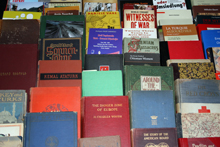
Every year the collection of the Armenian Genocide Museum is enriched with new and unique materials that greatly promote the research on Armenian Genocide and organization of museum exhibition. Those materials are mostly obtained with the support and donations of friends of the AGMI.
Donation made by “AGBU Young Professionals of Los Angeles” to the Armenian Genocide Museum-Institute in 2009 enriched the museum collection with unique materials.
Young Turks and Holocaust at Adana
11.12.2009
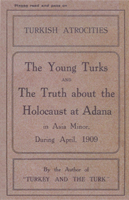
AGMI reprinted the little known book by Ferriman Duckett titled The Young Turks and the Truth about the Holocaust at Adana in Asia Minor during April 1909, which for the first time was published in London in 1913. The book is a valuable source on the Armenian massacres in Adana in 1909, which heralded upcoming genocide organized by Ottoman Turks. This book is a detailed account of the horrible massacres organized by Turkish authorities with the mass participation of the Turkish population of the Adana district.
The refference to the bloody and violent events was titled as Holocaust, since many victims were burned alive. The city of Adana and surrounding Armenian towns and villages also were set to fire.
In the introduction of the book Ferriman Duckett wrote:
President of Latvia paid a tribute at Tsitsernakaberd
10.12.2009
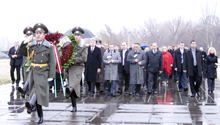
President of the Republic of Latvia Valdis Zatlers and his spouse Mrs. Lilita Zatlers who are in Armenia by the invitation of the President of the Republic of Armenia Serzh Sargsyan, visited Tsitsernakaberd Memorial Complex of the Armenian genocide. The Latvian delegation paid a tribute to the victims of the Armenian genocide and put flowers at the genocide memorial. The delegation took a tour of the Armenian Genocide Museum, where Mr. Zatlers left a note in the Commemoration book: “Human memory cannot be obliterated, as it remains forever and passes from generation to generation”. Afterwards the President of Latvia planted a fir at the Memorial alley.
Wuali ad din Yakun vs. Recep Tayyip Erdogan
The reproach of a Muslim: A century old response to the modern statements
09.12.2009

Recently the Prime Minister of Turkey Recep Tayyip Erdogan appeared with a statement saying that "A Muslim can never commit genocide". It is more correct to say that even the Muslims condemned and protested against inhuman treatment of Armenians during the genocide. A vivid examples of such demarches could be the texts of the Persian writer Jamalzadeh, Arab lawyer Fayez al Ghusein and edicts of Mecca’s sheriff Hussein, and many others, who referred to horrible massacres of Armenians in the Ottoman Turkey and expressed their anger, noting that the killing and violation of the innocent women and children are against the principles of Islam and Koran.
Horrible massacres of Armenians in Adana city in 1909 also created a protest among some Muslim and Turkish intellectuals. Among them was also Egyptian poet with Turkish origin, Wuali ad din Yakun, who published his little known protest letter in the Egyptian journal Moukhatan, on 16/29 April, 1909.
Those lines could be the best answer to the recent statements of the Prime Minister of Turkey.
Ceremonial events dedicated to the 100th Anniversary of the Adana massacres in Antelias
30.10.2009
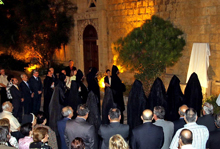
Two days conference dedicated to the 100th anniversary of the Adana massacres was opened under the patriarchal sanctification and leadership of His Holiness Aram I on October 29, 2009 in the Catholicosate of Cilicia. The researchers from Lebanon, Syria, Armenia, Cyprus, Greece, Italy, France, Iran and other countries took part in this conference. The director of the Armenian Genocide Museum & Institute Hayk Demoyan also took part in it.
The first evening of the conference in the Catholicosate in Antelias also started the week "Dedicated to the 100th anniversary of the Adana massacres", which was symbolized with the opening of the new cross stone (khachkar) dedicated to the 100th anniversary of the Adana massacres. After this ceremony the documentary photo exhibition consisting of nearly 60 photos presenting the massacres in Adana was opened. This exhibition has been organized with the assistance of the Armenian Genocide Museum & Institute, the Great House of the Cilicia and other archives.
An illustrated book published by AGMI
“Armenian Sport and Gymnastics in the Ottoman Empire”
13.10.2009
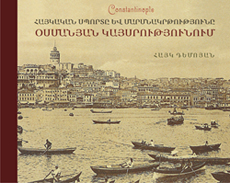
AGMI has published an illustrated book entitled “Armenian Sport and Gymnastics in the Ottoman Empire” (in Armenian, 220 pages) by Mr. HAYK DEMOYAN.
The history of sport and physical training among Armenian population of the Ottoman Empire is presented with more than five hundred photos.
The book refers to the activities of Armenian sport clubs established in Armenian populated cities of the Ottoman Empire, to the organization of Pan-Armenian Olympic Games, to the history of intensively developing athletic movement in Western Armenia and Cilicia, as well as refers to the sport unions of Armenian women, to sport competition and nationalism, to the establishment of Armenian scout movement. A separate chapter is dedicated to the Armenian sportsmen who fell victims to the Armenian Genocide.
The history of the development of Armenian sport and gymnastics in the Ottoman Empire takes its beginning from the end of 19th century, when the first athletic clubs and societies were established. Under the rule of the Sultan, being engaged in sports or athletics was strictly forbidden and those who broke this law were punished.
UNFINISHED "NUREMBERG"
ON THE OCCASSION OF THE 90-th ANNIVERSARY OF THE TRIAL OF YOUNG TURKS
10.10.2009
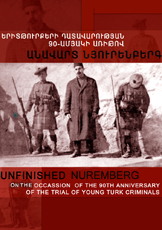
After the 1918 Mudros armistice, in order to get rid of the disgraced government of the Young Turks and prevent the possible punitive actions by the victorious Allies, the newly-organized Ahmed Izzet Pasha government, decided to bring the leaders of the Young Turks and the members of the Committee of the Party of “Ittihat ve Terakki” before court for involving the Ottoman Empire in the war and organizing Armenian massacres.
According to the decisions of 16 December 1918, Enquiry Commissions were set up (General Chairman former Ankara Governer Mazhar Bey) for the purpose of collecting evidence such as encoded telegraphs, official writings, instructions, orders, as well as eye-witness accounts of the massacres of Armenians.
The provinces of the Ottoman Empire were divided into ten investigative districts; prosecutors, inquiring judges and secretaries were appointed for each district.
A number of ministers of the Young Turks’ Government, party leaders, regional secretaries, attorneys, governors, servicemen and other officials were arrested.
AGMI received rare photos of Soghomon Tehlirian
08.10.2009
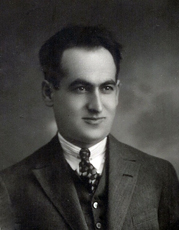
The photo collection of the Armenian Genocide museum-institute enriched with four exclusive photos of Soghomon Tehlirian, which kindly were donated by Levon A. Saryan, Ph.D. (Greenfield, Wisconsin, USA). All four represent family photos of Tehlirian.
Soghomon Tehlirian (1896–1960) was born in the village of Nerkin (Inner) Bagarij in Erzurum villayet of Western Armenia. He got his preliminary education in his birthplace and afterwards graduated in the Kedronakan (Central) college of Constantinople.
During the Armenian Genocide he witnessed the rape of his sisters and brutal killing of all his family members butchered by the Turkish gangs. During the death marches although he was injured and believed dead, he survived. Soghomon Tehlirian moved to Caucasus where he joined the Armenian voluntary detachment of Andranik.
In 1921 Soghomon Tehlirian was involved in the assassination operations of the main organizers of the Armenian genocide called “Nemesis”. His main task became to hunt down and take revenge on Talaat pasha - the chief organizer of the Armenian genocide.
Jean Jaurès – 150
(1859-1914)
07.10.2009
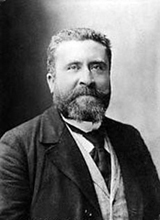
Jean Léon Jaurès (full name Auguste Marie Joseph Jean Léon Jaurès; 3 September 1859 – 31 July 1914) was a well-known French Socialist leader and Armenophil. Initially an Opportunist Republican, he evolved into one of the first social democrats, becoming the leader of the French Socialist Party in 1902.
In 1885 he was elected as a member of the French Parliament from Castres. During 1880s in the beginning of his political career he cooperated with the Republicans.
In 1904 with his efforts the “L’Humanite՛” was established.
For many times in his articles and public speeches Jean Jaurès severely criticized the suppressions and massacres of Armenians in the Ottoman Empire. In his November 3, 1896, February 22, March 15, 1897 speeches in the French parliament, he appeared with the condemnation of the Armenian massacres and the indifference of the Europe, particularly France towards the Armenian issue. In one of his speeches Jean Jaurès particularly mentioned:
The Documents of the League of Nations Prove the Armenian Genocide
03.10.2009

The decision to create the League of Nations during Paris peace conference in 1919 was aimed to maintain peace and promote the spirit of cooperation among nations. The League of Nations started its activities on 10 January, 1920. According to the League Covenant the main organs of the organization were the Assembly, the Council and the Secretariat, headed by the Secretary-General.
From the very beginning Great Britain and France were playing the leading role in this organization. The headquarters of the League was in Geneva (Switzerland), where the assemblies were held. In 1939, after waging of World War II, the League of Nations stopped its activities being unable to fulfill its main goal and mission. Officially the League of Nations was dissolved in 1946, after the formation of the United Nations Organization.
For several times Armenian question was in agenda of the League of Nations. The Republic of Armenia, proclaimed in May 1918, applied to the League of Nations in May 1920 for full membership. After long discussions in regard to this application finally it was rejected. The US candidacy for the mandate of Armenia also was in agenda of the League of Nations.
Famous rock stars at Tsitsernakaberd Memorial
02.10.2009

Ian Gillan, the lead singer and lyricist of "Deep Purple", Tony Ayommy, "Black Sabbath" 's guitar player, Jeff Downs, the keyboard player of "Asia" rock group, as well as tennis-player, winner of 1987 Wimbledon male tournament Pet Kesh and "Rock Helps Armenia" project author and Australian "Do something" organization’s director John Din arrived in Yerevan on October 1, Thursday.
Today, world known rock stars visited Tsitsernakaberd Memorial Complex, paid a tribute of respect to the victims of the Armenian genocide and put flowers at the memorial of the Armenian genocide. The delegation took a guided tour in the Armenian Genocide Museum, where they left a note in the Commemoration Book.
The Speaker of Belgian Senate paid a tribute at Tsitsernakaberd
02.10.2009
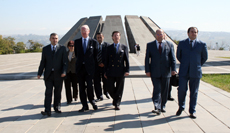
The delegation of the Belgian Parliament headed by the Speaker of the Belgian Senate Armand De Decker visited Tsitsernakaberd Memorial Complex. The Belgian delegation laid a wreath at Armenian Genocide monument and paid a tribute of respect to the victims of the Armenian genocide. Afterwards the Speaker of Belgian Senate took a tour in the Armenian Genocide Museum, where Mr. De Decker left a note in the Commemoration Book.
POGHOS ARAPIAN - THE FATHER FOUNDER OF THE OTTOMAN PRINT MEDIA
26.09.2009

Poghos Arapian (Hovhannisyan) was born in 1742 in village Apudjekh near the city of Akn. During the reign of Sultan Selim III Poghos Arapian with his father moved to Constantinople where he was a hawker for a while, then he profoundly studied contemporary printing techniques from his father-printer Hovhannes Atsaturean. Gradually improving and supplementing Armenian fonts created by his father and developing his printing skills, Poghos Arapian also initiated the creation of lettering templates that became the basis of Georgian and Turkish printing.
In 1760s there were several printing houses in Constantinople that operated with interruptions and not completely. Each printing house had its own foundry, where the lead letter templates were moulded, but they weren't sold because of strong competition. The printers did everything to prevent the expansion of Gutenberg's invention and to hold their monopoly in that sphere.
In 1770s Poghos Arapian became so famous that in 1781 Georgian king Heracles II invited him to Tiflis. Here he initiated the creation of Georgian printed letters and established a printing house. After completing his work Arapian got 800 dahekan from Georgian king, a considerable sum for that time.
THE ARMENIAN GENOCIDE AND THE INTERNATIONAL RED CROSS
23.09.2009
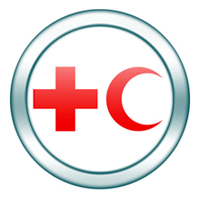
Up until the middle of 19th century, there was no a neutral international humanitarian principle or organization to provide necessary treatment for those who were wounded on the battlefield during the war. In 1859 Swiss writer, public activist Henry Dunant witnessed the battle of Solferino and organized the provision of the relief assistance for wounded. In his book entitled “A Memory of Solferino” (“Un souvenir de Solferino”) which was published in 1862 he put forward the idea of the necessity of the formation of international voluntary relief organization to help wounded soldiers in the case of war. The international conference held in Geneva in 1863 paved the way for the establishment of international humanitarian law and the International Red Cross organization.
The International Red Cross consists of several distinct organizations: the International Committee of the Red Cross, the International Federation of Red Cross and Red Crescent Societies and National Red Cross and Red Crescent Societies.
ARMENIANS IN THE OTTOMAN ARMY:
SERVICE AND DESTRUCTION
15.09.2009
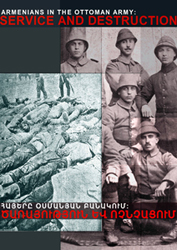
The history of formation and development of Ottoman Empire is closely connected with the formation and development of its military system. The Ottoman Turks permanently were at invasive warfare, but at the beginning they did not have enough military strength being minority in the occupied areas. To use the military strength of their Christian subjects and to meet increasing needs of their troops, Sultans began to impose a special tax called devshirme – human tax. Moreover the so called penjek was imposed on war prisoners according to which one of each five from subject peoples had to be conscripted into the Ottoman army. The Ottoman rulers continually conscripted strong and healthy boys and teenagers who after being converted into Islam were sent to ajemi (inexperienced, unpracticed) troops, where they got military training and the strongest and battle-worthy ones were included in the yenicheri troops.
The yenicheri troops were created in 1361-1363 during the reign of Sultan Murad I and mainly were formed of Christians who were converted into Islam forcibly. Many generations of Armenian children were taken away from their native places to serve for the interests of the Ottoman state.
Armenian genocide and fears of modern Turkey
25.08.2009
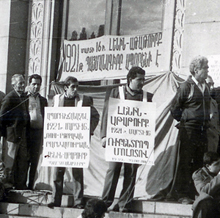 In occasion of the 70th anniversary of Molotov-Ribbentrop pact
signed in August 23, 1939
In occasion of the 70th anniversary of Molotov-Ribbentrop pact
signed in August 23, 1939
At first blush, one may ask what is the relation between Molotov-Ribbentrop Pact (where Poland was divided between Nazi Germany and Soviets, and Baltic states came under Soviet rule), and the Armenian-Turkish issue? Historical evidence clearly shows that the approbation of such agreements by Bolsheviks initially occurred 19 years before this Nazi and Bolshevik fatal Pact.
In the late 1920s, the secret agreements between Mustafa Kemal Ataturk, founder of modern Turkey and Vladimir Lenin, Bolshevik and Kemalist troops, jointly launched military aggression against the Republic of Armenia. As a result of this war, Armenia was forced to sign humiliating agreements with both aggressors and as a result ceased to exist shortly afterwards. Eastern territories of the Republic of Armenia were annexed by Turkish troops and later were attached to the Republic of Turkey. The larger part of Armenia was Sovietized by Russia and became a part of the USSR in 1922.
The president of Serbia visited Tsitsernakaberd Memorial Complex
28.07.2009

By the invitation of the president of Armenia Serzh Sargsyan, the president of the Republic of Serbia, Boris Tadic arrived to Armenia on July 28 for a two day official visit.
In the framework of his official visits, the president of Serbia visited also Tsitsernakaberd Memorial Complex; laid a wreath at the monument to the victims of the Armenian Genocide. The Serbian delegation paid a tribute of respect to the victims of the Armenian genocide and put flowers at the memorial of the Armenian genocide. Then the president of Serbia planted a fir at the Memory Alley.
The delegation took a tour of the Armenian Genocide Museum, where Mr. Tadic left a note in the Commemoration Book.
The history of the establishment of Armenian and Turkish Theaters in the Ottoman Empire
07.07.2009
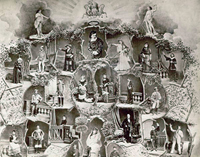
Historic evidence shows the establishment and the first 50 years of the development of the Turkish theater are strongly connected with the activity of Ottoman Armenians. The proof is that Armenians and Greeks were the first to bring any innovations from Europe to the Ottoman Empire. The 1850s are considered for Ottoman Armenians as the period of cultural revival. Armenian schools, publishing and media, sciences and literatures all experienced an awakening following the innovation and modernization in the important centers of the Armenian culture, such as Constantinople and Smyrna.
At the same time, numerous young Armenians graduated from the famous European universities. They imported many new ideas and innovations from Europe. Among these innovations, was theater; Armenian welcomed it with great enthusiasm, especially by Armenians from Constantinople.
The president of Cyprus visited Tsitsernakaberd Memorial Complex
07.07.2009
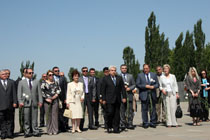
At the invitation of the president of Armenia Serzh Sargsyan, the president of the Republic of Cyprus Dimitris Christofias, accompanied by his spouse Mrs. Elsi Christofias, arrived to Armenia on July 6 on a two day state visit.
Mr. Dimitris Christofias, accompanied by the high-ranking officials of RA and Cyprus visited to the Tsitsernakaberd Memorial Complex. The Cyprian delegation paid a tribute of respect to the victims of the Armenian genocide and put flowers at the memorial of the Armenian genocide. Then the president of Cyprus planted a fir at the Memory Alley. The delegation took a tour of the Armenian Genocide Museum, where Mr. Christofias left a note in the Commemoration Book: “The condemnation of the Armenian genocide is a duty of the modern world as a whole. Cyprus was and will always be alongside with Armenia in the struggle for the recognition of the Genocide committed by the Young Turks against the Armenian genocide”.
Apostle Bartholomew’s burial site still is a restricted area
02.07.2009
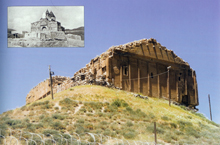
Armenian Apostolic church was founded by two Apostle’s St. Bartholomew and St. Thaddeus, who where martyred during their mission in the southern regions of historical Armenia in the first century A. D. The St. Thaddeus's shrine is currently on the Iranian territory and the Armenian monastery St. Thaddeus built over it is currently a popular pilgrimage place for Christians and Moslems. The government of Iran gives importance to the preservation of country’s Christian heritage and the Armenian Monastic ensembles is added to UNESCO's World Heritage List.
The monastery of St. Bartholomew (now in the South-East of Turkey) was built in the 4th century at the site of the martyrdom of the Apostle Bartholomew. The burial site of the Apostle Bartholomew was inside of the Cathedral, which was the important pilgrimage place for Armenians before the genocide.
Antony Krafft-Bonnard – 140
(1869-1945)
02.07.2009
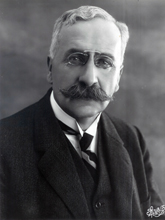
Krafft-Bonar was born in a family of a pharmacist in city Aigle, canton Vaud, Switzerland, in June 15, 1869. He graduated from school in Laussane, in 1888, and then he studied theology in Lozano, Berlin, Paris till 1893. From 1893 to 1919 he was spiritual director (clergyman) in different settlements of Switzerland. Later he left the church and completely devoted himself to the Armenian question and the solution of number of problems of Armenian genocide survivors. He got married in 1894, had 4 children – 3 daughters and a son, who also joined to activities of Armenophiles, as their father.
Krafft-Bonnard started his Armenophile activities from 1896, when he had a speech on horrifying consequences of Hamidian massacres in village Begnin, Switzerland, where he was pastor. Impressed with the stunning appeal of Krafft-Bonnard several Swiss families expressed willingness to adopt Armenian children who became orphans after Armenian massacres in the Ottoman Empire. Soon with the efforts of Bonnard an institute was found in village Begnin called “Armenian hearth”, the aim of which was to shelter and take care of hundreds of Armenian refugees in Switzerland. Cooperating with George Cote, the founder of Armenophile activities in Switzerland, Krafft-Bonar was actively engaged in works of organization “Swiss society of migration and patronage of Armenian orphans” and became its president from 1896.
Mikheil Saakashvili visited Tsitsernakaberd Memorial Complex
25.06.2009

The president of Georgia Mikheil Saakashvili, who arrived to Yerevan with an official visit, accompanied by the high-ranking officials of RA and Georgia, visited to the Tsitsernakaberd Memorial Complex. The Georgian delegation paid a tribute of respect to the victims of the Armenian genocide and put flowers at the memorial of the Armenian genocide.
After the entire president Saakashvili watered the fir planted by him at the Memory Alley several years ago during his visit to Armenia.
Online exhibition
Armenian Genocide: front-page coverage
23.06.2009
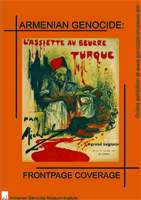
Armenian genocide has always been in the spotlight of Armenian as well as foreign media. The role of global media coverage is vital in the sense that it touches upon numerous issues concerning Armenian genocide. Especially notable are English, Russian, French and American coverage and publications on issues pertaining Hamidian massacres, Adana atrocities and of course, the Genocide of 1915-1922.
Publications with particular photos are predominantly remarkable for they convey valuable information about genocide as a phenomenon, its process and consequences. Foreign media publications condemning the violence of Ottoman power against Armenians serve as an indirect evidence of the fact that the Turkish atrocities were indeed genocide committed against Armenians.
The online exhibition on front-page coverage of the Armenian genocide by the foreign media is presented first time. The coverage of the issue began appearing in the beginning of the 19th century and continues finding its place in the modern day media publications.
The young historians from the CIS in AGMI
18.06.2009

The 4th International Summer School of the young historians from the CIS countries on the theme of “History of Daily Routine in the Study of History in the CIS Countries” is held in Yerevan from 15-21 June.
On June 18 the participants of the Summer School arriving to Yerevan from RF, Moldova, Belarus, Ukraine, Tajikistan, Kazakhstan, Uzbekistan, Kyrgyzstan, etc. visited the Tsitsernakaberd Memorial Complex. Young historians put flowers at the memorial of the Armenian Genocide; took a tour in the Armenian Genocide Museum.
Foreign Minister of Estonia paid a tribute of respect
11.06.2009
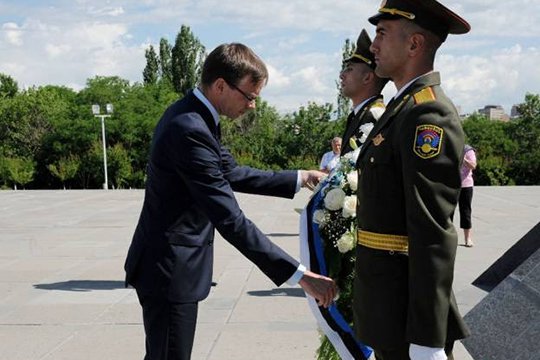
The Foreign Minister of Estonia Urmas Paet paid a working visit to Armenia. The delegation headed by the minister Mr. Paet visited the Tsitsernakaberd Memorial Complex. The guests from Estonia paid a tribute of respect to the victims of the Armenian genocide and put flowers at the memorial of the Armenian genocide.
The director of the Armenian Genocide Museum – Institute, Dr. Hayk Demoyan told the details of the story of the Armenian Genocide.
The President of Croatia visited Tsitsernakaberd Memorial Complex
22.05.2009

On the invitation of Armenian president Serzh Sargsyan today the President of Croatia Stjepan Mesic paid an official visit to Armenia. Mr. Mesic accompanied by the Minister of Justice of RA, the Mayor of Yerevan and the director of the Armenian Genocide Museum-Institute, visited the Tsitsernakaberd Memorial Complex.
The president of Croatia, who is the first time in Armenia, put a wreath at the memorial of the Armenian Genocide; took a tour in the Armenian Genocide Museum. The director of the Museum Mr. Hayk Demoyan represented the story of Armenian Genocide to the president of Croatia.
At the end S.Mesic left a note in the museum’s Commemoration Book: “I bend down before all the victims of human violence”.
Greek community pays tribute of respect
19.05.2009
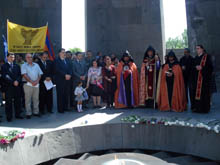
The Greek community of Armenia leaded by Greek ambassador to RA Ionise Carintios visited the Tsitsernakaberd Memorial Complex and put flowers at the memorial of the Armenian Genocide victims on 19th of May, on the anniversary of the genocide of Greek in Pontus.
During the atrocities committed by Turks against 700 thousand Greeks in Pontus from 1916 to 1923 approximately 353 thousand fell victims, the other part took refuge in Greece, Armenia and other countries. According to the words of I.Carintios nobody has the right to forget such a crime. “Unless Turkey doesn’t accept its crime, we must do our best to get the civil society informed about it”,- he said.
Lecture series by Prof. Vahakn Dadrian in AGMI
08.05.2009

On May 5, 6 and 7 AGMI organized series of public lectures with the participation of the famous Armenian-American historian, professor of sociology and leading expert in the Armenian Genocide studies, Prof. Vahakn Dadrian.
The main goal of the AGMI public lectures is to inform the broad audience about the scientific opinions and new researches in the sphere of the genocide studies.
In his presentations Professor Dadrian touched upon following topics:
“Unfinished “Nuremberg”: Young Turk criminals in the Republican Turkey’s political elite”. Prof. Dadrian thoroughly touched upon the issue of the engagement of Ottoman military and civil officials in committing of massacres, stressing on the issue of the connection of the Armenian Genocide and the creation of Kemalist military-political establishment in the early period of Republican Turkey.
The First Lady of RF visited Tsitsernakaberd Memorial Complex
05.05.2009
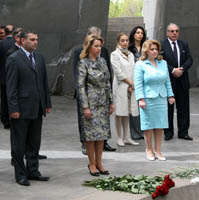
The First Lady of the Russian Federation, Svetlana Medvedeva, arrived in Yerevan at the invitation of the First Lady of Armenia, Rita Sargsyan.
Rita Sargsyan and Svetlana Medvedeva visited the Tsitsernakaberd Memorial Complex and put flowers at the memorial of the Armenian Genocide victims. The First Ladies took a tour of the Armenian Genocide Museum afterwards, where the First Lady of RF left a note in the museum’s Commemoration Book, next the note of President of RF D. Medvedev: “Were are mourning together. The horrifying pages of history make us think about the eternity. I whish the best to the staff of the museum-institute, and the prosperity and peace for all Armenians.”
A liturgy for the victims of the Armenian Genocide
24.04.2009
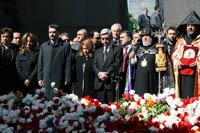
Today is the day of commemoration of innocent victims of the Armenian Genocide.
This year marks the 90th anniversary of April 24 as a day of commemoration. A special committee was formed in Constantinople, in March 1919, by a group of Ottoman Armenian intellectuals who survived the Armenian Genocide. The main goal of this committee was the organization of commemoration ceremonies dedicated to the 4th anniversary of the Armenian Genocide. Due to the efforts of these people the memory of the victims of Armenian Genocide was commemorated among the Armenians of Constantinople for the first time in 1919. Since the first commemoration of the Armenian Genocide victims in Istanbul, April 24 officially was adopted as “Day of Mourning and Commemoration”. And up to now every year since early morning hundred of thousands of Armenians from Armenia and its vast Diaspora have been marching to Tsitsernakaberd Memorial Complex, Yerevan to remember all who perished 94 years ago during the Armenian Genocide.
THE RELENTLESS MEMORY OF AMERICA & THE ARMENIAN GENOCIDE
18.04.2009
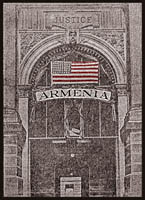
The current turmoil within Turkey’s politics renders this an excellent opportunity to ask whether the recognition of the Armenian genocide at the hands of Ottoman government is important simply for the sake of establishing historical justice or proving a series of events that establish historical facts. Neither US House of Representatives nor Senate should believe any harm could befall the US-Turkish strategic partnership or even escalate Armenian-Turkish relations to a much-anticipated detente in the future. The very problem lies within the representation and interpretation of the issue. Wrong assumptions often result in wrong perceptions. And in this world, perception is reality.
But being of sound mind and in order for us not to get caught up in trivial assumption and perceptions we should stop and find out who actually benefits from the recognition and condemnation of the Armenian Genocide? The answer is a surprising one: The American people and their memory. Unfortunately, the topic of the Armenian Genocide and its consequences are not taught in most US public schools and Universities. Nevertheless, every American citizen should know that his or her country became a champion in world history. Americans provided humanitarian assistance and very necessary food aide for all those suffering Christians: i.e., Assyrians, Greeks and most of all Armenians who suffered the ravages of WWI and the genocidal policies of the Turkish government.
“Armenian Golgotha”: a story based
on the memories of an eyewitness of the Armenian Genocide
17.04.2009
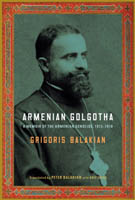
The other day was republished “Armenian Golgotha” by Grigoris Balakian, translated by Peter Balakian with Aris Sevag. “Armenian Golgotha” is the most dramatic and comprehensive eyewitness account of the first genocide of XX century.
The book was originally published in Armenian in two volumes as Armenian Golgotha: Episodes from the Armenian Martyrology from Berlin to Zor, 1914-1920 (Vienna: Mekhitarist Press, 1922) and Armenian Golgotha, Volume 2: Episodes from the Armenian Martyrology from Berlin to Der Zor (Paris: Imprimerie Araxes, 1959.)
On April 24, 1915, the priest Grigoris Balakian was arrested along with some 250 other intellectuals and leaders of Constantinople’s Armenian community. Is was the beginning of the Ottoman Turkish government’s systematic attempt to eliminate the Armenian people from Turkey; it was a campaign the continued through World War I and the fall of the Ottoman Empire, by which time more than a million Armenians had been annihilated and expunged from their historic homeland. For Grigoris Balakian, himself condemned, it was also the beginning of a four-year ordeal during which he would bear witness to a seemingly endless caravan of blood.
ADANA MASSACRES 1909: UNKNOWN SCENES OF THE TRAGEDY
15.04.2009
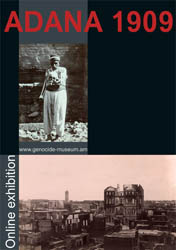 The Adana Massacre was the second series of large-scale massacres of Armenians to break out in the Ottoman Empire. The atrocities committed in the province of Adana in April 1909 coincided with the counter-revolution staged by supporters of Sultan Abdul Hamid (Abdul-Hamid) II (1876-1909) who had been forced to restore the Ottoman Constitution as a result of the 1908 Young Turk Revolution led by the Committee of Union and Progress (CUP). A prosperous region on the Mediterranean coast encompassing the old principality of Cilicia, once an independent Armenian state between the eleventh and fourteenth centuries, the province of Adana had been spared the 1890s massacres. The disturbances were most severe in the city of Adana where a reported 4,437 Armenian dwellings were torched, resulting in the razing of nearly half the town and prompting some to describe the resulting inferno as a "holocaust." The outbreaks spread throughout the district and an estimated 30,000 Armenians were reported killed. While attempts at resistance in Adana proved futile, and Armenians in smaller outlying villages were brutally slaughtered, two towns inhabited mostly by Armenians organized a successful defense. Hadjin (Hajen in Armenian) in the Cilician Mountains withstood a siege, while the 10,000 Armenians of Dortyol (Chorkmarzban in Armenian) held off 7,000 Turks who had surrounded their town and cut off its water supply.
European officials paid a tribute of respect
07.04.2009
 The delegation headed by the Co-chairperson of the EU-Armenia parliamentary cooperation commission Marie Ann Izler Beginn, visited the Tsitsernakaberd Memorial Complex and put flowers at the memorial of the Armenian Genocide victims. Then the guests took a tour in the Armenian Genocide Museum, where Hayk Demoyan, director of the AGMI, introduced them the history of the Armenian Genocide.
The guests touched upon Armenian-Turkish relations, history of the Armenian Genocide and issue of importance of the prevention of genocides. At the end of the tour questions and answers followed.
At the Origins of Commemoration:
The 90th Anniversary Declaring April 24 as a Day of Mourning and
Commemoration of the Armenian Genocide
31.03.2009
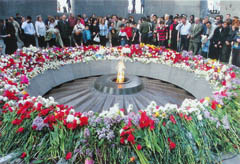
2009 marks the 90th anniversary of April 24 as a day of commemoration. Here is the history of this important event:
A special committee was formed in Constantinople, in March 1919, by a group of Ottoman Armenian intellectuals who survived the Armenian Genocide. The main goal of this committee was the organization of commemoration ceremonies dedicated to the 4th anniversary of the Armenian Genocide. The committee, known as “The April 11th Board of Ceremonial Mourning” consisted of 13 members including Yevphime Avetisian, Zaruhi Galamkarian, Mari Stambulian, Perchuhi Parsamian, Miss Arpiar, Tigran Zaven, Merujan Parsamyan, Hakob Siruni, Gevorg Mesrop, Tagvor Suqiasian, Dr. Barsegh Tinanian, Shahan Perperian and Hovhannes Poghosian. Due to the efforts of these people the memory of the victims of Armenian Genocide was commemorated among the Armenians of Constantinople for the first time in 1919. Armenian writer, publicist and public figure Hakob Siruni wrote in his memoirs: “The mourning ceremony became a tradition. Since then, the 24th of April was adopted as a symbol of mourning.”
Genocide Scholars Urge Obama to recognize Armenian Genocide
21.03.2009
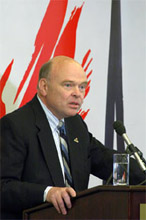
WASHINGTON (A.W.) - Earlier this month, the International Association of Genocide Scholars (IAGS) sent a letter to President Barack Obama urging him to recognize the Armenian Genocide.
The letter, signed by IAGS president Gregory Stanton, read:
“Dear President Obama:
We write this open letter to you as the leading international organization of scholars who study genocide. As April approaches, we urge you to “refer to the mass slaughter of Armenians as genocide in your commemorative statement,” as you urged President George W. Bush to do in a letter dated March 18, 2005.
On January 19, 2008 you voiced your conviction “that the Armenian Genocide is not an allegation, a personal opinion, or a point of view, but rather a widely documented fact supported by an overwhelming body of historical evidence.” We hope that you will be able to affirm that conviction this April.
“Auction of Souls”: the first genocide movie ever made
26.02.2009

On the occasion of the 90th anniversary of the “Ravished Armenia”, the AGMI has issued a memorial postcard and has created an on-line exhibition at official web-site of the Armenian Genocide Museum-Institute.
“Ravished Armenia”, one of the first documentary memoirs of an eyewitness of Armenian Genocide was published in 1918, in New York. In this book Arshaluys (Aurora) Mardiganian, a girl from Chmshkatsag, Armenian populated town in the Ottoman Empire, gave a detailed account of the terrible experiences she endured during the deportations. At the age of fourteen Arshaluys was beaten and tortured in harems of Turkish officials and Kurdish tribesmen.
The book “Ravished Armenia” was completed when American Committee for Armenian and Syrian Relief offered to create a film based on the scenario of the book and all the profit, which later on reached $30 million, would be given to 60.000 Armenian orphans in the Near East for relief purposes. In 1918, at Metro Goldwin Mayer studio, director Oscar Apfel made “Auction of Souls” silent film, which actually became not only the first movie on the Armenian genocide, but also the first genocide movie ever made. More than 10.000 Armenian residents of Southern California, including 200 deported children, participated in the scenes.
The Foreign Minister of Georgia Grigol Vashadze visited Tsisernakaberd Memorial Complex
21.02.2009
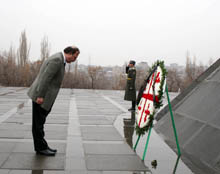
The Foreign Minister of Georgia Grigol Vashadze visited the Tsisernakaberd Memorial Complex and put flowers at the memorial of the Armenian Genocide victims. The Foreign Minister of Georgia and his delegation take a tour of the Armenian Genocide Museum, where Mr. Vashadze left a note in the museum’s Commemoration Book: “It’s a very regrettable that the peoples couldn’t learn lessons from the history till now”.
Official Website Of The Armenian Genocide Museum & Institute (AGMI) Wins Grand Prix in Pan-Armenian Website Competition
17.01.2009
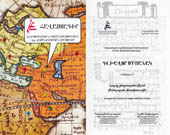
Yerevan, Armenia--The Third annual Pan-Armenian website competition took place in Yerevan from November 15th- December 25th, 2009. The current competition was devoted to the 500th anniversary of Armenian printing. Exactly 377 entries were submitted for competition.
The official website of the Armenian Genocide Museum & Institute (AGMI) www.genocide-museum.am received the Grand Prix. AGMI also was nominated as a winner in the “E-Science” category. This achievement grants the AGMI website to take part in the World competition of websites.
New revealed Italian documents on the Armenian genocide
23.12.2008

The Armenian Genocide Museum – Institute has published diplomatic documents of the Historical-diplomatic archive of the Ministry of Foreign Affairs of Italy on the Armenian Question 1913-1923 from the series of “Armenian Genocide: diplomatic documents” being published by AGMI.
The only Great Power of those times is Italy in which’s archives preserved documents on the Armenian question and the Armenian Genocide till the last times were almost unknown to the Armenian society. At the beginning of 2005 by the intercession of the Embassy of Armenia in Italy, we’ve got permission for researching these documents in the Historical Diplomatic Archive of the Ministry of foreign affairs of Italy.
The researches showed that the documents concerning to the Armenian people are deposited under the name Armenia. This fact is very interesting, as we see that the territory on which were living Armenians in the Ottoman Empire was comprehended as Armenia.
Director of the AGMI met with the Armenian community in Paris
19.12.2008
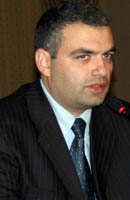
Paris, France--On December 18th, 2009, Dr. Hayk Demoyan, the Director of Armenian Genocide Museum & Institute at Alex Manukyan Cultural Center lecturing on the current developments in the Armenian-Turkish relations, focusing on a new dynamics and challenges.
During the meeting, Dr. Demoyan touched upon the new progress being made within Armenian-Turkish relations today, the aims of Armenian side, the new conceptual approaches to the focal issues of genocide recognition, as well as the necessity to develop a general Armenian approach. He also briefed about the present activities and future plans of the AGMI.
The representatives of Armenian organizations and the Paris Armenian community were present at the event. Dr. Demoyan also engaged the audience in a brief question and answer session at the end of the discussion.
“Prior to the Auction of Souls”
A graphical novel about a survivor of the Armenian Genocide
10.12.2008
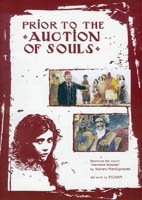 On December 10, the presentation of the graphical novel “Prior to the Auction of Souls” novel by Tigran Mangasaryan, sponsored by Sossi Ghazarian took place in the Armenian Genocide Museum-Institute’s hall named after Komitas. The book is written on the basis of the eyewitness of Armenian genocide Aurora Mardiganyan’s memoirs titled as “Ravished Armenia”, which was first published in 1918 in New York in English.
In one of the first documentary memoirs of the eyewitness of Armenian genocide, the author, survivor of the Genocide Arshaluys (Aurora) Mardiganyan from Chmshkatsag gave a detailed account of the terrible experiences she endured during the genocide.
In 1918 in California, at “Metro Goldwin Mayer” studio, director Oscar Apfel made a silent film “Auction of Souls”, which actually became the first genocide movie, based on Aurora Mardiganyan’s memoirs. The premiere of the “Auction of Souls” was held on February 16, 1919, in Plaza Hotel, New York under the auspices of Oliver Harriman and George Vanderbilt, members of American Committee for Armenian and Syrian Relief.
Tigran Mangasaryan’s graphical novel was published in connection with the 90th anniversary of the shooting of “Auction of Souls”.
"A people in Exile"
AGMI has released a new book on the Armenian Genocide
05.12.2008
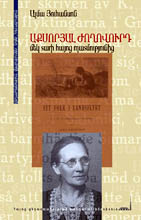 AGMI published memories of Swedish missionary Alma Johansson, eyewitness of the Armenian Genocide, with the Armenian, English and Russian texts in one volume. Swedish missionary Alma Johansson was born in 1880. In 1901, as an activist of Swedish women missionary movement she left for Western Armenia to provide humanitarian assistance to Armenians who suffered Hamidian massacres. In 1910-1915 Johansson was in the city of Mush where she was involved in care of Armenian orphans in the orphanage of German Deutscher Hulfsbund missionary organization.
From 1923 to 1941 Johansson was involved in relief work in Salonika, helping Armenian refugees sheltered in Greece. With the efforts of Johansson a manufacture was founded in Salonika.
Alma Johansson was an eyewitness of the Armenian Genocide; her eyewitness testimonies were published in two small volumes in Swedish – “A People in Exile” (1930) and “The Life of Refugees” (1931).
Both in these volumes and her reports to German and American diplomats Johansson testifies about the massacre and deportation of Armenians committed by Turkish authorities of the Ottoman Empire and the poor condition of refugees who survived the massacres.
Alma Johansson died in Stockholm in 1974.
| 




